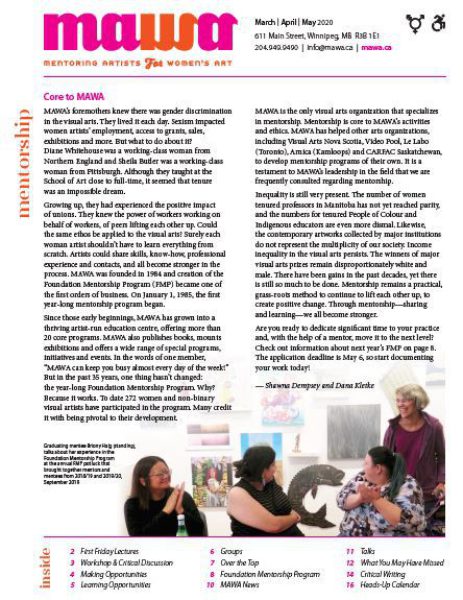
Material Investigations by Helga Jakobson
In Material Investigations, MAWA’s Focussed Mentorship with Barb Hunt, six artists set out to explore unusual media and expand their practice and research. Throughout their time together, they challenged and supported one another, making the three-month intensive program a fruitful and exploratory one. While each artist’s themes were rooted in their own personal cosmologies, as a collectivity their works are all products of earnest attempts at queering subject/object binaries.
In her book Vibrant Matter, Jane Bennett discusses how subjects and objects are never really entirely passive or stable. All matter is alive and in process, reality is in constant morph and shift. In Internal Investigations, the Focussed Mentorship’s resulting exhibition, each of the artists’ investigations materialized as deep explorations, both physically and conceptually, of matter in flux.
Each artist’s work reminds us of and points to the impact that one being has on their environment, on other people and in space. The challenge of showcasing works that differ incredibly from one object/subject to the next was resolved by the group in an ongoing respect for one another and for the space. The collectivity was in their common goal of exploring matter, made present in the shared exhibition space through the showcasing of individual exercises undertaken throughout the immersive program or in its reflection. This made for an exhibition situated within the complex challenges and benefits of working collectively in compromised times. We need to find ways of thinking-with each other in sympoiesis, in allowing for ecologies to form in collectively producing systems. Systems and exhibitions like these ones allow for works that stand strongly alone individually but resonate and shimmer off one another, in turn allowing them to vibrate in new and unexpected ways.
The choices of material and expression in the exhibition varied from matter that implied bodily use to material investigated through touch and material imbued with human experience, allowing the artists to explore the corporeality and limitations as well as this vibrancy of matter. For example, Dawn Knight’s work utilized the medium of sand to play at once with the material’s semiotic and physical weight. Looking into the patterns that can comfort us but also hold us captive, her engagement with sand and its ability to block, protect and morph calls to mind the ever-changing and far from static nature of existence.
In the time in which we find ourselves, the epoch with the proposed and commonly cited moniker of the Anthropocene, there is a need to remember the impact that humans have on the earth. We are living on a planet that has become compromised and irreversibly re-shaped, making it incredibly timely for an exhibition that thinks-with material and our human relation to it. Melanie Matheson’s way of thinking-with includes multi-layered, exploratory, tactile processing. Her use of refuse, concrete and paper, among other materials, speaks to her eagerness to reimagine the matter that humans build and build with.
Another example of work that looks to the complexities of living on a damaged earth is found in Allison Moore’s installation, which blurs the lines between scientific research, kitchen-witchery and craftsmanship. A lot of the works in her installation are unfired, existing as temporal objects, at once useful and beautiful and at once unusable and fragile. They are reminders of the entropic nature of organic life. Everything goes back to the earth; delicacy and liminality are worthy of witnessing and examination.
In thinking-with objects and material, Object-Oriented Feminism (OOF) is incredibly useful. Its roots are in Object-Oriented Ontology, which rejects privileging human existence over that of nonhuman objects. OOF adds to this process of de-privileging with a recognition of one’s own object-ness. Object-Oriented Feminism does not attempt to arrive at a fixed or “correct” interpretation of objects and material. The challenges that Briony Haig, Barb Bottle and Loricia Pacholko-Matheson present in their works align with these approaches to material consideration. Their works ask viewers to question the representation of the female form and how women are treated like objects.
Moments like this immersive mentorship generate a shared language and innovation. As Bennett puts it, “Any action is always a trans-action, and any act is really but an initiative that gives birth to a cascade of legitimate and bastard progeny.” The idea of vibrancy brings forward feelings of energy, enthusiasm and resonance. In this exhibition one can clearly see that the catalyst of material consideration created just this: a vibrancy in collectivity.
Helga Jakobson is a transdisciplinary artist living on Treaty One Territory.

